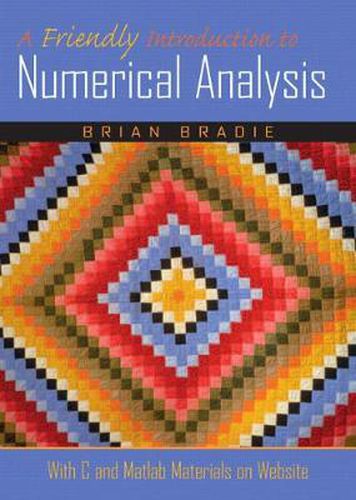Readings Newsletter
Become a Readings Member to make your shopping experience even easier.
Sign in or sign up for free!
You’re not far away from qualifying for FREE standard shipping within Australia
You’ve qualified for FREE standard shipping within Australia
The cart is loading…






For one or two term undergraduate/graduate-level courses in Numerical Methods in mathematics departments (for numerical analysis courses), CS departments and engineering departments. This student-friendly introduction to the fundamental concepts and techniques of numerical analysis/numerical methods develops concepts and techniques in a clear, concise, easy-to-read manner, followed by fully-worked examples. Application problems drawn from the literature of many different fields prepares students to use the techniques covered to solve a wide variety of practical problems. *Unique topical coverage - Provides extensive coverage of material not typically covered, or only briefly discussed, in other texts - e.g., eigenvalue problem for nonsymmetric matrices; improper integrals (removable singularities, derivative singularities, logarithmic singularities and infinite limits of integration); non-Dirichlet boundary conditions, the handling of artificial singularities and eigenvalue problems for one-dimensional boundary value problems; non-Dirichlet boundary conditions, the multigrid method and irregular domains for elliptic partial differential equations; (source and decay terms, non-Dirichlet boundary conditions, polar coordinates and problems in two space dimensions for parabolic partial differential equations; one-dimensional hyperbolic partial differential equations, numerical dispersion and diffusion); the convection-diffusion equation. *More than 200 fully-worked examples - The examples are set in a different type face and are printed with wider margins to highlight the separation between theory (the development of methods) and practice (worked examples). *An extensive set of application problems - Used both as worked examples and exercises. Problems are drawn from the literature of many different fields (physics, biology, chemistry, chemical engineering, thermodynamics, heat transfer, electrostatics, ecology, manufacturing, sociology, etc.). *Emphasis on the key concepts of rate/order of convergence, stability and assessing the accuracy of numerical results. *Organised thematically around mathematical problems - with each chapter devoted to a single type of problem (e.g. rootfinding, numerical calculus differentiation and integration, the matrix eigenvalue problem, elliptic partial differential equations). Within each chapter, the presentation begins with the simplest, most basic methods and progresses gradually to more advanced topics. Early chapters generally contain easier material, and the level of difficulty and complexity increases in later chapters. *Chapter Overviews - Presents several real-world problems relating to the specific mathematical problem which will be treated in the chapter. *Exercise Sets - Features more than 400 numbered exercises. *Code available for instructors - Code for all methods discussed in the text will be available for faculty for both MAPLE and MATLAB (through a web site). *Absence of pseudocode - The author believes that with pseudocode provided, students feel like they don’t need to really understand the techniques; they just have to be able to convert the pseudocode into whatever the language of choice happens to be.
$9.00 standard shipping within Australia
FREE standard shipping within Australia for orders over $100.00
Express & International shipping calculated at checkout
For one or two term undergraduate/graduate-level courses in Numerical Methods in mathematics departments (for numerical analysis courses), CS departments and engineering departments. This student-friendly introduction to the fundamental concepts and techniques of numerical analysis/numerical methods develops concepts and techniques in a clear, concise, easy-to-read manner, followed by fully-worked examples. Application problems drawn from the literature of many different fields prepares students to use the techniques covered to solve a wide variety of practical problems. *Unique topical coverage - Provides extensive coverage of material not typically covered, or only briefly discussed, in other texts - e.g., eigenvalue problem for nonsymmetric matrices; improper integrals (removable singularities, derivative singularities, logarithmic singularities and infinite limits of integration); non-Dirichlet boundary conditions, the handling of artificial singularities and eigenvalue problems for one-dimensional boundary value problems; non-Dirichlet boundary conditions, the multigrid method and irregular domains for elliptic partial differential equations; (source and decay terms, non-Dirichlet boundary conditions, polar coordinates and problems in two space dimensions for parabolic partial differential equations; one-dimensional hyperbolic partial differential equations, numerical dispersion and diffusion); the convection-diffusion equation. *More than 200 fully-worked examples - The examples are set in a different type face and are printed with wider margins to highlight the separation between theory (the development of methods) and practice (worked examples). *An extensive set of application problems - Used both as worked examples and exercises. Problems are drawn from the literature of many different fields (physics, biology, chemistry, chemical engineering, thermodynamics, heat transfer, electrostatics, ecology, manufacturing, sociology, etc.). *Emphasis on the key concepts of rate/order of convergence, stability and assessing the accuracy of numerical results. *Organised thematically around mathematical problems - with each chapter devoted to a single type of problem (e.g. rootfinding, numerical calculus differentiation and integration, the matrix eigenvalue problem, elliptic partial differential equations). Within each chapter, the presentation begins with the simplest, most basic methods and progresses gradually to more advanced topics. Early chapters generally contain easier material, and the level of difficulty and complexity increases in later chapters. *Chapter Overviews - Presents several real-world problems relating to the specific mathematical problem which will be treated in the chapter. *Exercise Sets - Features more than 400 numbered exercises. *Code available for instructors - Code for all methods discussed in the text will be available for faculty for both MAPLE and MATLAB (through a web site). *Absence of pseudocode - The author believes that with pseudocode provided, students feel like they don’t need to really understand the techniques; they just have to be able to convert the pseudocode into whatever the language of choice happens to be.